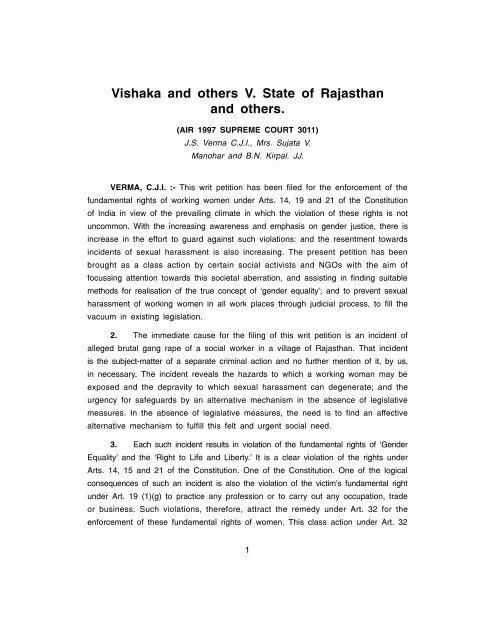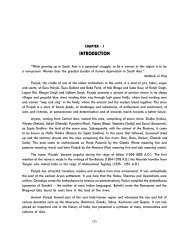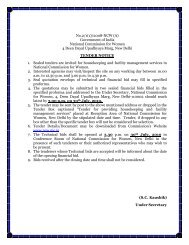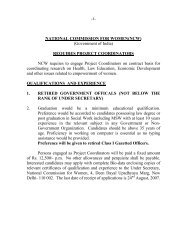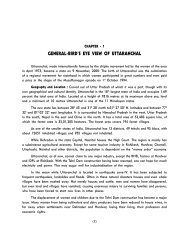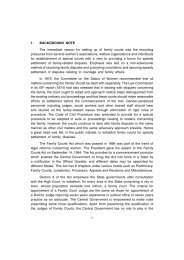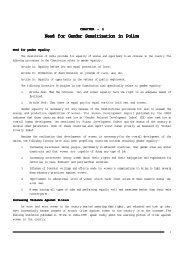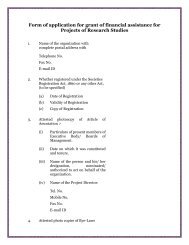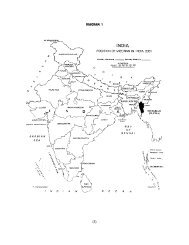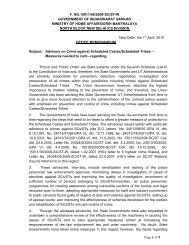Vishaka and others V. State of Rajasthan and others.
Vishaka and others V. State of Rajasthan and others.
Vishaka and others V. State of Rajasthan and others.
- No tags were found...
You also want an ePaper? Increase the reach of your titles
YUMPU automatically turns print PDFs into web optimized ePapers that Google loves.
<strong>Vishaka</strong> <strong>and</strong> <strong>others</strong> V. <strong>State</strong> <strong>of</strong> <strong>Rajasthan</strong><strong>and</strong> <strong>others</strong>.(AIR 1997 SUPREME COURT 3011)J.S. Verma C.J.I., Mrs. Sujata V.Manohar <strong>and</strong> B.N. Kirpal. JJ.VERMA, C.J.I. :- This writ petition has been filed for the enforcement <strong>of</strong> thefundamental rights <strong>of</strong> working women under Arts. 14, 19 <strong>and</strong> 21 <strong>of</strong> the Constitution<strong>of</strong> India in view <strong>of</strong> the prevailing climate in which the violation <strong>of</strong> these rights is notuncommon. With the increasing awareness <strong>and</strong> emphasis on gender justice, there isincrease in the effort to guard against such violations: <strong>and</strong> the resentment towardsincidents <strong>of</strong> sexual harassment is also increasing. The present petition has beenbrought as a class action by certain social activists <strong>and</strong> NGOs with the aim <strong>of</strong>focussing attention towards this societal aberration, <strong>and</strong> assisting in finding suitablemethods for realisation <strong>of</strong> the true concept <strong>of</strong> ‘gender equality’; <strong>and</strong> to prevent sexualharassment <strong>of</strong> working women in all work places through judicial process, to fill thevacuum in existing legislation.2. The immediate cause for the filing <strong>of</strong> this writ petition is an incident <strong>of</strong>alleged brutal gang rape <strong>of</strong> a social worker in a village <strong>of</strong> <strong>Rajasthan</strong>. That incidentis the subject-matter <strong>of</strong> a separate criminal action <strong>and</strong> no further mention <strong>of</strong> it, by us,in necessary. The incident reveals the hazards to which a working woman may beexposed <strong>and</strong> the depravity to which sexual harassment can degenerate; <strong>and</strong> theurgency for safeguards by an alternative mechanism in the absence <strong>of</strong> legislativemeasures. In the absence <strong>of</strong> legislative measures, the need is to find an affectivealternative mechanism to fulfill this felt <strong>and</strong> urgent social need.3. Each such incident results in violation <strong>of</strong> the fundamental rights <strong>of</strong> ‘GenderEquality’ <strong>and</strong> the ‘Right to Life <strong>and</strong> Liberty.’ It is a clear violation <strong>of</strong> the rights underArts. 14, 15 <strong>and</strong> 21 <strong>of</strong> the Constitution. One <strong>of</strong> the Constitution. One <strong>of</strong> the logicalconsequences <strong>of</strong> such an incident is also the violation <strong>of</strong> the victim’s fundamental rightunder Art. 19 (1)(g) to practice any pr<strong>of</strong>ession or to carry out any occupation, tradeor business. Such violations, therefore, attract the remedy under Art. 32 for theenforcement <strong>of</strong> these fundamental rights <strong>of</strong> women. This class action under Art. 321
Article 253 :“253. Legislation for giving effect to international agreements.- Notwithst<strong>and</strong>inganything in the foregoing provisions <strong>of</strong> this Chapter, Parliament has power to makeany law for the whole or any part <strong>of</strong> the territory <strong>of</strong> India for implementing any treaty.Agreement or convention with any other country or countries or any decision madeat any international conference, association or other body.”Seventh Schedule :“List 1 - Union List :xxx xxx xxx14. Entering into treaties <strong>and</strong> agreements with foreign countries <strong>and</strong>implementing <strong>of</strong> treaties, agreements <strong>and</strong> conventions with foreign countries.xxx xxx xxx"7. In the absence <strong>of</strong> domestic law occupying the field, to formulate effectivemeasures to check the evil <strong>of</strong> sexual harassment <strong>of</strong> working women at all workplaces, the contents <strong>of</strong> international Conventions <strong>and</strong> norms are significant for thepurpose <strong>of</strong> interpretation <strong>of</strong> the guarantee <strong>of</strong> gender equality, right to work with hum<strong>and</strong>ignity in Arts. 14, 15, 19 (1) (g) <strong>and</strong> 21 <strong>of</strong> the Constitution <strong>and</strong> the safeguardsagainst sexual harassment implicit therein. Any International Convention notinconsistent with the fundamental rights <strong>and</strong> in harmony with its spirit must be readinto these provisions to enlarge the meaning <strong>and</strong> content there<strong>of</strong>, to promote theobject <strong>of</strong> the constitutional guarantee. This is implicit from Art. 51 (c) <strong>and</strong> the enablingpower <strong>of</strong> the Parliament to enact laws for implementing the International Conventions<strong>and</strong> norms by virtue <strong>of</strong> Art. 253 read with Entry 14 <strong>of</strong> the Union List in SeventhSchedule <strong>of</strong> the Constitution. Article 73 also is relevant. It Provides that the executivepower <strong>of</strong> the Union shall extend to the matters with respect to which Parliament haspower to make laws. The executive power <strong>of</strong> the Union is, therefore, available till theParliament enacts legislation to expressly provide measures needed to curb the evil.8. Thus, the power <strong>of</strong> this Court under Art. 32 for enforcement <strong>of</strong> thefundamental rights <strong>and</strong> the executive power <strong>of</strong> the union have to meet the challengeto protect the working women from sexual harassment <strong>and</strong> to make their fundamentalrights meaningful. Governance <strong>of</strong> the society by the rule <strong>of</strong> law m<strong>and</strong>ates this4
equirement as logical concomitant <strong>of</strong> the constitutional scheme. The exerciseperformed by the Court in this matter is with this common perception shared with thelearned Solicitor General <strong>and</strong> other members <strong>of</strong> the Bar who rendered valuableassistance in the performance <strong>of</strong> this difficult task in public interest.9. The progress made at each hearing culminated in the formulation <strong>of</strong>guidelines to which the Union <strong>of</strong> India gave its consent through the learned SolicitorGeneral, indicating that these should be the guidelines <strong>and</strong> norms declared by thisCourt to govern the behaviour <strong>of</strong> the employers <strong>and</strong> all <strong>others</strong> at the work places tocurb this social evil.10. Gender equality includes protection from sexual harassment <strong>and</strong> right towork with dignity, which is a universally recognised basic human right. The commonminimum requirement <strong>of</strong> this right has received global acceptance. The InternationalConventions <strong>and</strong> norms are, therefore, <strong>of</strong> great significance in the formulation <strong>of</strong> theguidelines to achieve this purpose.11. The obligation <strong>of</strong> this Court under Art. 32 <strong>of</strong> the Constitution for theenforcement <strong>of</strong> these fundamental rights in the absence <strong>of</strong> legislation must be viewedalong with the role <strong>of</strong> judiciary envisaged in the Beijing <strong>State</strong>ment <strong>of</strong> Principles <strong>of</strong> theIndependence <strong>of</strong> the judiciary in the LAWASIA region. These principles <strong>of</strong> theIndependence <strong>of</strong> the Judiciary in the LAWASIA region. These principles were acceptedby the Chief Justices <strong>of</strong> the Asia <strong>and</strong> the Pacific at Beijing in 1995 as thoserepresenting the minimum st<strong>and</strong>ards necessary to be observed in order to maintainthe independence <strong>and</strong> effective functioning <strong>of</strong> the judiciary . The objectives <strong>of</strong> thejudiciary mentioned in the Beijing <strong>State</strong>ment are :“Objectives <strong>of</strong> the Judiciary :10. The objectives <strong>and</strong> functions <strong>of</strong> the judiciary include following :Law;(a)to ensure that all persons are able to live securely under the Rule <strong>of</strong>(b) to promote, within the proper limits <strong>of</strong> the judicial function, the observance<strong>and</strong> the attainment <strong>of</strong> human rights; <strong>and</strong>(c)the <strong>State</strong>.”to administer the law impartially among persons <strong>and</strong> between persons <strong>and</strong>5
24. <strong>State</strong>s should include in their reports information about sexual harassment,<strong>and</strong> on measures to protect women from sexual harassment <strong>and</strong> other forms <strong>of</strong>violence <strong>of</strong> coercion in the work place.”The Government <strong>of</strong> India has ratified the above resolution on June 25, 1993with some reservations which are not material in the present context. At the FourthWorld Conference on Women in Beijing, the Government <strong>of</strong> India has also made an<strong>of</strong>ficial commitment, inter alia, to formulate <strong>and</strong> operationalize a national policy onwomen which will continuously guide <strong>and</strong> inform action at every level <strong>and</strong> in everysector; to set up a Commission for Women’s to act as a public defender <strong>of</strong> women’shuman rights; to institutionalise a national level mechanism to monitor theimplementation <strong>of</strong> the Platform for Action. We have, therefore, no hesitation in placingreliance on the above for the purpose <strong>of</strong> construing the nature <strong>and</strong> ambit <strong>of</strong>constitutional guarantee <strong>of</strong> gender equality in our Constitution.14. The meaning <strong>and</strong> content <strong>of</strong> the fundamental rights guaranteed in theConstitution <strong>of</strong> India are <strong>of</strong> sufficient amplitude to encompass all the facets <strong>of</strong> genderequality including prevention <strong>of</strong> sexual harassment or abuse. Independence <strong>of</strong> judiciaryforms a part <strong>of</strong> our constitutional scheme. The international conventions <strong>and</strong> normsare to be read into them in the absence <strong>of</strong> enacted domestic law occupying the fieldwhen there is no inconsistency between them. It is now an accepted rule <strong>of</strong> judicialconstruction domestic law when there is no inconsistency between them <strong>and</strong> there isa void in the domestic law. The High Court <strong>of</strong> Australia in Minister for Immigration<strong>and</strong> Ethnic Affairs V. Teoh, 128 ALR 353, has recognised the concept <strong>of</strong> legitimateexpectation <strong>of</strong> its observance in the absence <strong>of</strong> a contrary legislative provisions, evenin the absence <strong>of</strong> a Bill <strong>of</strong> Rights in the Constitution <strong>of</strong> Australia.15. In Nilabati Behera v. <strong>State</strong> <strong>of</strong> Orissa, (1993) 2 SCC 746 : (1993 AIRSCW 2366), a provision in the ICCPR was referred to support the view taken that ‘an enforceable right to compensation is not alien to the concept <strong>of</strong> enforcement <strong>of</strong>a guaranteed right’, as a public law remedy under Art. 32, distinct from the privatelaw remedy in torts. There is no reason why these international conventionals <strong>and</strong>norms cannot, therefore, be used for construing the fundamental rights expresslyguaranteed in the Constitution <strong>of</strong> India which embody the basic concept <strong>of</strong> genderequality in all spheres <strong>of</strong> human activity.7
Apparel Export Promotion Council v. A.K. Chopra(AIR 1999 SUPREME COURT 625)Dr. A.S. An<strong>and</strong>, C.J.I. And V. N. Khare, J.Dr. ANAND, C.J.I. :- Special Leave granted.2. Does an action <strong>of</strong> the superior against a female employee which isagainst moral sanctions <strong>and</strong> does not withst<strong>and</strong> test <strong>of</strong> decency <strong>and</strong> modesty notamount to sexual harassment ? Is physical contact with the female employee anessential ingredient <strong>of</strong> such a charge ? Does the allegation that the superior ‘tried tomolest’ a female employee at the “place <strong>of</strong> work”, not constitute an act unbecoming<strong>of</strong> good conduct <strong>and</strong> behaviour expected from the superior ? These are some <strong>of</strong> thequestions besides the nature <strong>of</strong> approach expected from the law Courts to casesinvolving sexual harassment which come to the forefront <strong>and</strong> require our consideration.3. Reference to the facts giving rise to the filing <strong>of</strong> the present Appeal bySpecial Leave at this stage is appropriate :4. The respondent was working as Private Secretary to the Chairman <strong>of</strong> theApparel Export Promotion Council, the appellant herein. It was alleged that on 12-8-1988, he tried to molest a woman employee <strong>of</strong> the Council, Miss X (name withheldby us ) who was at the relevant time working as a Clerk-sum-Typist. She was notcompetent or trained to take dictations. The respondent, however, insisted that shego with him to the Business Centre at Taj Palace Hotel for taking dictation from theChairman <strong>and</strong> type out the matter. Under the pressure <strong>of</strong> the respondent, she wentto take the dictation from the Chairman. While Miss X was waiting for the Directorin the room, the respondent tried to sit too close to her <strong>and</strong> despite her objection didnot give up his objectionable behaviour. She later on took dictation from the Director.The respondent told her to type it at the Business Centre <strong>of</strong> the Taj palace Hotel,which is located in the Basement <strong>of</strong> the Hotel. He <strong>of</strong>fered to help her so that hertyping was not found fault with by the Director. He volunteered to show her theBusiness centre for getting the matter typed <strong>and</strong> taking advantage <strong>of</strong> the isolatedplace, again tried to sit close to her <strong>and</strong> touch her despite her objections. The drafttyped matter was corrected by Director (Finance) who asked Miss X to retype the12
same. The respondent again went with her to the Business Centre <strong>and</strong> repeated hisovertures. Miss X told the respondent that she would “leave the place if he continued<strong>of</strong> behave like that” . The respondent did not stop. Though he went out from theBusiness Centre for a while, he again came back <strong>and</strong> resumed his objectionable acts.According to Miss X, the respondent had tried to molest her physically in the lift alsowhile coming to the basement but she saved herself by pressing the emergencybutton, which made the door <strong>of</strong> the lift to open. On the next day, that is on 16thAugust, 1988 Miss x was unable to meet the Director (Personnel) for lodging hercomplaint against the respondent as he was busy. She succeeded in meeting him onlyon 17th August, 1988 <strong>and</strong> apart from narrating the whole incident to him orallysubmitted a written complaint also. The respondent was placed under suspension videan order dated 18 th August, 1988. A charge - sheet was served on him to whichhe gave a reply denying the allegations <strong>and</strong> asserting that “ the allegations wereimaginary <strong>and</strong> motivated.” Shri J.D. Giri, a Director <strong>of</strong> the Council, was appointed asan Enquiry Officer to enquire into the charges framed against the respondent. On thebehalf <strong>of</strong> the management with a view to prove the charges as many as six witnesseswere examined including Miss X. The respondent also examined seven witnesses. TheEnquiry Officer after considering the documentary <strong>and</strong> oral evidence <strong>and</strong> thecircumstances <strong>of</strong> the case arrived at the conclusion that the respondent had actedagainst moral sanctions <strong>and</strong> that his acts against Miss X did not withst<strong>and</strong> the test<strong>of</strong> decency <strong>and</strong> modesty. He, therefore, held the charges levelled against therespondent as proved.5. The Enquiry Officer in his report recorded the following amongst other,findings :“8.1 Intentions <strong>of</strong> Shri A. K. Chopra were ostensibly manifested in his actions<strong>and</strong> behaviour, despite reprim<strong>and</strong>s from Miss X he continued to act against moralsanctions;8.2 Dictation <strong>and</strong> subsequent typing <strong>of</strong> the matter provided Shri A. K. Chopranecessary opportunity to take Miss X to the Business Centre a secluded place.Privacy in the Business Centre room made his ulterior motive explicit <strong>and</strong> clear.8.3 Any other conclusion on technical niceties which Shri A. K. Chopra triedto purport did not withst<strong>and</strong> the test <strong>of</strong> decency <strong>and</strong> modesty.”13
6. The Enquiry Officer concluded that Miss X was molested by therespondent at Taj Palace Hotel on 12th August, 1988 <strong>and</strong> that the respondent hadtried to touch her person in the Business Centre with ulterior motives despitereprim<strong>and</strong>s by her. The Disciplinary Authority agreeing with the report <strong>of</strong> the EnquiryOfficer, imposed the penalty <strong>of</strong> removing him from service with immediate effect on28th June, 1989.7. Aggrieved, by an order <strong>of</strong> removal from service, the respondent filed adepartmental appeal before the Staff Committee <strong>of</strong> the appellant. It appears that therewas some difference <strong>of</strong> opinion between the Members <strong>of</strong> the Staff Committee <strong>and</strong> theChairman <strong>of</strong> the Staff Committee during the hearing, but before any decision couldbe arrived at by the Staff Committee, the respondent, on the basis <strong>of</strong> someunconfirmed minutes <strong>of</strong> the Staff Committee meeting, filed a Writ Petition in the HighCourt inter alia challenging his removal from service. On January 30, 1992, the writpetition was allowed <strong>and</strong> respondents Nos. 1 <strong>and</strong> 3, therein, were directed to act uponthe decision <strong>of</strong> the Staff Committee, assuming as if th decision, as alleged, had beentaken at the 34th Meeting <strong>of</strong> the staff Committee on 25th July, 1990. The appellantchallenged the judgment <strong>and</strong> order <strong>of</strong> the High Court dated 30th January, 1992,through Special Leave Petition (Civil) No. 3204 <strong>of</strong> 1992 in this Court. While settingaside the judgment <strong>and</strong> order <strong>of</strong> the High Court dated 30th January, 1992, a DivisionBench <strong>of</strong> this Court opined :“We have been taken through the proceeding <strong>of</strong> the meeting starting from 33rdmeeting up to 38th meeting by both the learned Counsel appearing for the respectiveparties. Considering the same it appears to us that the alleged decision taken on thesaid Agenda No. 5 in the 33rd <strong>and</strong> 34th meeting is in dispute <strong>and</strong> final decision onthe same has not yet been taken <strong>and</strong> the alleged resolution on the said item No. 5still awaits ratification. In that view <strong>of</strong> the matter, the High Court was wrong indeciding the disputed question <strong>of</strong> fact in favour <strong>of</strong> Respondent No. 1. We, thereforeset aside the impugned order <strong>of</strong> the Delhi High Court as according to us the finaldecision on the resolution taken on the said Agenda No. 5 has not yet been finallyratified. We are not inclined to consider the other questions sought to be raised inthis appeal <strong>and</strong> the said questions are kept open. In view <strong>of</strong> the pendency <strong>of</strong> thematter for a long time, we direct the appellant - company to convince the meeting <strong>of</strong>Staff Committee as early as practicable but not exceeding two months from today so14
14. The learned single Judge, did not doubt the correctness <strong>of</strong> theoccurrence. He did not disbelieve the complainant. On a re-appreciation <strong>of</strong> theevidence on the record, the learned single Judge, however, drew his own inference<strong>and</strong> found that the respondent had “tried to molest” but since he had not “ actuallymolested” the complainant, therefore, the action <strong>of</strong> the respondent did not warrantremoval from service. The learned single Judge while directing the reinstatement <strong>of</strong>the respondent observed :“15. In the totality <strong>of</strong> facts <strong>and</strong> circumstances, ends <strong>of</strong> justice would meet if thepetitioner is reinstated in service but he would not be entitled to any back wages.The Council shall consider this period as on duty <strong>and</strong> would give himconsequential promotion to the petitioner. He shall be entitled to all benefits exceptback wages. The petitioner shall be posted in any other <strong>of</strong>fice outside Delhi, at leastfor a period <strong>of</strong> two years.”(Emphasis Ours)15. The Division Bench <strong>of</strong> the High Court also while dismissing the L. P.A.filed by the appellant did not doubt the correctness <strong>of</strong> the occurrence. It alsoconcluded that since the respondent had not actually molested Miss x <strong>and</strong> had onlytried to assault her <strong>and</strong> had “ not managed” to make any physical contact with her,a case <strong>of</strong> his removal from service was not made out. Both the learned single Judge<strong>and</strong> the Division Bench did not doubt the correctness <strong>of</strong> the following facts:1. That Miss x was a subordinate employee while the respondent was thesuperior <strong>of</strong>ficer in the organization;2. That Miss x was not qualified to take any direction <strong>and</strong> had so told therespondent;3. That the respondent pressurized her to come with him to Taj Palace Hotelto take dictation despite her protestation, with an ulterior design;4. That the respondent taking advantage <strong>of</strong> his position, tried to molest MissX <strong>and</strong> in spite <strong>of</strong> her protestation, continued with his activities which were against themoral sanctions <strong>and</strong> did not withst<strong>and</strong> the test <strong>of</strong> decency <strong>and</strong> modesty;17
5. That the respondent tried to sit too close to Miss X with ulterior motives<strong>and</strong> all along Miss X kept reprim<strong>and</strong>ing him but to no avail;6. That the respondent was repeating his implicit unwelcome sexualadvances <strong>and</strong> Miss X told him that if he continued to behave in that fashion, shewould leave the place;7. That the respondent acted in a manner which demonstrated unwelcomesexual advances, both directly <strong>and</strong> by implication;8. That action <strong>of</strong> the respondent created an intimated <strong>and</strong> hostile workingenvironment in so far as Miss X is concerned.16. The above facts are borne out from the evidence on the record <strong>and</strong> onthe basis <strong>of</strong> these facts, the departmental authorities keeping in view the fact that theactions <strong>of</strong> the respondent were considered to be subversive <strong>of</strong> good discipline <strong>and</strong>not conductive to proper working in the appellant Organization where there were anumber <strong>of</strong> female employees, took action against the respondent <strong>and</strong> removed himfrom service.17. The High Court appears to have overlooked the settled position that indepartmental proceeding, the Disciplinary Authority is the sole Judge <strong>of</strong> facts <strong>and</strong> incase an appeal is presented to the Appellate Authority, the Appellate Authority hasalso the power/ <strong>and</strong> jurisdiction to re-appreciate the evidence <strong>and</strong> come to its ownconclusion, on facts, being the sole fact finding authorities . Once findings <strong>of</strong> fact,based on appreciation <strong>of</strong> evidence are recorded, the High Court in writ jurisdiction maynot normally interfere with those factual findings unless it finds that the recordedfindings were based either on no evidence or that the findings were wholly perverse<strong>and</strong> / or legally untenable. The adequacy or inadequacy <strong>of</strong> the evidence is notpermitted to be canvassed before the High Court. Since, the High Court does not sitas an Appellate Authority, over the factual findings recorded during departmentalproceedings, while exercising the power <strong>of</strong> judicial review, the High Court cannotnormally speaking substitute its own conclusion, with regard to the guilt <strong>of</strong> thedelinquent, for that <strong>of</strong> the departmental authorities. Even ins<strong>of</strong>ar as imposition <strong>of</strong>penalty or punishment is concerned, unless the punishment or penalty imposed by theDisciplinary or the Departmental Appellate Authority, is either impermissible or suchthat it shocks the conscience <strong>of</strong> the High Court, it should not normally substitute its18
own opinion <strong>and</strong> impose some other punishment or penalty. Both the learned singleJudge <strong>and</strong> the Division Bench <strong>of</strong> the High Court, it appears, ignored the well-settledprinciple that even though Judicial Review <strong>of</strong> administrative action must remain flexible<strong>and</strong> its dimension not closed, yet the Court in exercise <strong>of</strong> the power <strong>of</strong> judicial reviewis not concerned with the correctness <strong>of</strong> the findings are reasonably supported byevidence <strong>and</strong> have been arrived at through proceedings which cannot be faulted withfor procedural illegalities or irregularities which vitiate the process by which thedecision was arrived at . Judicial Review, it must be remembered, is directed notagainst the decision, but is confined to the examination <strong>of</strong> the decision-makingprocess. Lord Haltom in Chief Constable <strong>of</strong> the North Wales Police v. Evans (1982)3All ER 141, observed:“The purpose <strong>of</strong> judicial review is to ensure that the individual receives fairtreatment, <strong>and</strong> not to ensure that the authority, after according fair treatment, reaches,on a matter which it is authorized by law to decide for itself, a conclusion which iscorrect in the eyes <strong>of</strong> the Court.”18. Judicial Review, not being an appeal from a decision, but a review <strong>of</strong> themanner in which the decision was arrived at, the Court while exercising the power<strong>of</strong> Judicial Review must remain conscious <strong>of</strong> the fact that if the decision has beenarrived at by the Administrative after following the principles established by law <strong>and</strong>the rules <strong>of</strong> natural justice <strong>and</strong> the individual has received a fair treatment to meetthe case against him, the Court cannot substitute, its judgment for that <strong>of</strong> theAdministrative Authority on a matter which fell squarely within the sphere if jurisdiction<strong>of</strong> that authority.19. It is useful to note the following observations <strong>of</strong> this Court in Union <strong>of</strong>India v. Sardar Bahadur (1972) 4 SCC 618: (1972 Lab IC 627 at Pp. 630-31) :“Where there are some relevant materials which the authority has accepted <strong>and</strong>which materials may reasonably support the conclusion that the <strong>of</strong>ficer is guilty, it isnot the function <strong>of</strong> the High Court exercising its jurisdiction under Article 226 to reviewthe materials <strong>and</strong> to arrive at an independent findings in the materials.If the enquiry has been properly held the question <strong>of</strong> adequacy or reliability <strong>of</strong>the evidence cannot be canvassed before the High Court.”19
20. After a detailed review <strong>of</strong> the law on the subject, this Court While dealingwith the jurisdiction <strong>of</strong> the High Court or Tribunal to interfere with the disciplinarymatters <strong>and</strong> punishment in Union <strong>of</strong> India v. Parma N<strong>and</strong>a (1989) 2 SCC 177 : (AIR1989SC 1185) opined (at P. 1192 <strong>of</strong> AIR) :“We must unequivocally <strong>State</strong> that the jurisdiction <strong>of</strong> the Tribunal to interfere withthe disciplinary matters or punishment cannot be equated with an appellate jurisdiction.The Tribunal cannot interfere with the findings <strong>of</strong> the Enquiry Officer or CompetentAuthority where they are not arbitrary or utterly perverse. It is appropriate to rememberthat the power to impose penalty on a delinquent <strong>of</strong>ficer is conferred on the competentauthority either by an Act <strong>of</strong> Legislature or Rules made under the proviso to Article309 <strong>of</strong> the Constitution. If there has been an enquiry consistent with the rules <strong>and</strong>in accordance with principles <strong>of</strong> natural justice what punishment would meet the ends<strong>of</strong> justice is a matter <strong>of</strong> exclusively within the jurisdiction <strong>of</strong> the competent authority.If the penalty can lawfully be imposed <strong>and</strong> is imposed on the proved misconduct, theTribunal has no power to substitute its own discretion for that <strong>of</strong> the authority.”21. In B. C. Chaturvedi v. Union <strong>of</strong> India (1995) 6 SCC 749 : (1995 AIRSCW 4374), this Court opined ( at P. 4379 <strong>of</strong> AIR SCW) :“The disciplinary authority is the sole Judge <strong>of</strong> facts. Where appeal is presentedthe appellate authority has coextensive power to reappreciate the evidence or thenature <strong>of</strong> punishment . In a disciplinary Enquiry, the strict pro<strong>of</strong> <strong>of</strong> legal evidence <strong>and</strong>findings on that evidence are not relevant. Adequacy <strong>of</strong> evidence cannot be permittedto be canvassed before the Court/ Tribunal.”Further it was held (at P. 4380 <strong>of</strong> AIR SCW) :“A review <strong>of</strong> the above legal position would establish that the disciplinaryauthority, <strong>and</strong> on appeal the appellate authority, being fact-finding authorities haveexclusive power to consider the evidence with a view to maintain discipline. They areinvested with the discretion to impose appropriate punishment keeping in view themagnitude <strong>of</strong> gravity <strong>of</strong> the misconduct. The High Court/Tribunal, while exercising thepower <strong>of</strong> judicial review, cannot normally substitute its own conclusion on penalty <strong>and</strong>impose some other penalty. If the punishment imposed by the disciplinary authorityor the appellate authority shocks the conscience <strong>of</strong> the High Court/Tribunal, it wouldappropriately mould the relief, either directing the disciplinary/appellate authority to20
econsider the penalty imposed, or to shorten the litigation, it may itself, in exceptional<strong>and</strong> rare cases, impose appropriate punishment with cogent reasons in supportthere<strong>of</strong>.”(Emphasis supplied)22. Again in Government <strong>of</strong> Tamil Nadu v. A. Rajap<strong>and</strong>ian (1995)1 SCC 216:(1994 AIR SCW 4833) this Court opined ( at p. 4834 <strong>of</strong> AIR ) :“It has been authoritatively settled by string <strong>of</strong> authorities <strong>of</strong> this Court that theAdministrative Tribunal cannot sit as a Court <strong>of</strong> appeal over a decision based on thefindings <strong>of</strong> the inquiring authority in disciplinary proceedings. Where there is somerelevant material which the disciplinary authority has accepted <strong>and</strong> which materialreasonably supports the conclusion reached by the disciplinary authority, it is not thefunction <strong>of</strong> the Administrative Tribunal to review the same <strong>and</strong> reach different findingthan that <strong>of</strong> the disciplinary authority. The Administrative Tribunal, in the case, hasfound no fault with the proceeding held by the inquiring authority. It has quashed thedismissal order by re-appreciating the evidence <strong>and</strong> reaching a finding different thanthat <strong>of</strong> the inquiring authority.”(Emphasis ours)23. In the established facts <strong>and</strong> circumstances <strong>of</strong> this case, we have nohesitation to hold, at the outset, that both the learned single Judge <strong>and</strong> the Division<strong>of</strong> the High Court fell into patent error in interfering with findings <strong>of</strong> fact recorded bythe departmental authorities <strong>and</strong> interfering with the quantum <strong>of</strong> punishment, as if theHigh Court was sitting in appellate jurisdiction. From the judgements <strong>of</strong> the learnedsingle Judge as well as the Division Bench, it is quite obvious that the findings withregard to an “unbecoming act” committed by the respondent, as found by theDepartmental Authorities, were not found fault with even on re-appreciation <strong>of</strong>evidence. The High Court did not find that the occurrence as alleged by thecomplainant had not taken place. Neither the learned single Judge nor the DivisionBench found that findings recorded by the Enquiry Officer or the DepartmentalAppellate Authority were either arbitrary or even perverse. As a matter <strong>of</strong> fact, theHigh Court found no fault whatsoever with the conduct <strong>of</strong> Enquiry. The direction <strong>of</strong>the learned single Judge to the effect that the respondent was not entitled to backwages <strong>and</strong> was to be posted outside the city for at least two years, which was upheld21
y the Division Bench, itself demonstrates that the High Court believed thecomplainants’s case fully for otherwise neither the withholding <strong>of</strong> back wages nor adirection to post the respondent outside the city for at least two years, which wasupheld by the Division Bench, itself demonstrates that the High Court believed thecomplainants’s case fully for otherwise neither the withholding <strong>of</strong> back wages nor adirection to post the respondent outside the city for at least two years was necessary.The High Court in our opinion fell in error in interfering with the punishment, whichcould be lawfully imposed by the departmental authorities on the respondent for hisproven misconduct. To hold that since the respondent had not “actually molested “Miss X <strong>and</strong> that he had only “tried to molest” her <strong>and</strong> had “not managed” to makephysical contact with her, the punishment <strong>of</strong> removal from service was not justifiedwas erroneous. The High Court should not have substituted its own discretion for that<strong>of</strong> the Authority. What punishment was required to be imposed, in the facts <strong>and</strong>circumstances <strong>of</strong> the case, was a matter which fell exclusively within the jurisdiction<strong>of</strong> the competent authority <strong>and</strong> did not warrant any interference by the High Court .The entire approach <strong>of</strong> the High Court has been faulty. The impugned order <strong>of</strong> theHigh Court cannot be sustained on this ground alone. But there is another aspect <strong>of</strong>the case which is fundamental <strong>and</strong> goes to the root <strong>of</strong> the case <strong>and</strong> concerns theapproach <strong>of</strong> the Court while dealing with cases <strong>of</strong> sexual harassment at the place <strong>of</strong>work <strong>of</strong> female employees.24. The High Court was examining disciplinary proceedings against therespondent <strong>and</strong> was not dealing with criminal trial <strong>of</strong> the respondent. The High Courtnot find that there was no evidence at all <strong>of</strong> any kind <strong>of</strong> “molestation” or “assault” onthe person <strong>of</strong> Miss X. It appears that the High Court re-appreciated the evidence whileexercising power <strong>of</strong> judicial review <strong>and</strong> gave meaning to the expression “molestation”as if it was dealing with a finding in a criminal trial. Miss X had used the expression“molestation” in her complaint in a general sense <strong>and</strong> during her evidence she hasexplained what she meant. Assuming for the sake <strong>of</strong> argument that the respondentdid not manage to establish any “ physical contact” with Miss X, though the statement<strong>of</strong> management witness Suba Singh shows that the respondent had put his h<strong>and</strong> onth e h<strong>and</strong> <strong>of</strong> Miss X when he surprised them in the Business Centre, it did not meanthat the respondent had not made any objectionable overtures with sexual overtones.From the entire tenor <strong>of</strong> the cross-examination to which Miss X was subjected to by22
the respondent, running in to about 17 typed pages <strong>and</strong> containing more than onehundred & forty questions <strong>and</strong> answers in cross-examinations, it appears that the effort<strong>of</strong> respondent was only to play with the use <strong>of</strong> the expressions “molestation” <strong>and</strong> “physical assault” which was relevant. The statement <strong>of</strong> Miss X before the EnquiryOfficer as well as in her complaint unambiguously conveyed in no uncertain terms asto what her complaint was. The entire episode reveals that the respondent hadharassed, pestered <strong>and</strong> subjected Miss X, by a conduct which is against moralsanctions <strong>and</strong> which did not withst<strong>and</strong> the test <strong>of</strong> decency <strong>and</strong> modesty <strong>and</strong> whichprojected unwelcome sexual advances. Such as action on the part <strong>of</strong> the respondentwould be squarely covered by the term “sexual harassment.” The following statementmade by Miss X at the enquiry:“When I was there in the Chairman’s room I told Mr. Chopra that this waswrong <strong>and</strong> he should not do such things. He tried to persuade me by talking ...............I tried to type the material but there were so many mistake. He helped me in typing.There he tried to blackmail me ............... He tried to sit with me. In between he triedto touch me ....................... Mr. Chopra again took me to th e Business Centre.Thereafter again he tried. I told him I will go out if he does like this. Then he wentout. Again he came back. In between he tried.”(Emphasis supplied)Unmistakably shows that the conduct <strong>of</strong> the respondent constituted an actunbecoming <strong>of</strong> good behaviour, expected from the superior Officer. Repeatedly, didMiss X state before the Enquiry Officer that the respondent tried to sit close to her<strong>and</strong> touch her <strong>and</strong> that she reprim<strong>and</strong>ed him by asking that he ‘should not do thesethings.’ The statement <strong>of</strong> Miss Rama Kanwar, the management witness to the effectthat when on 16th August she saw Miss X <strong>and</strong> asked her the reason for being upset,Miss X kept on weeping <strong>and</strong> told her “ she could not tell being unmarried, she couldnot explain what had happened to her .” The material on the record, thus, clearlyestablishes an unwelcome sexually determined behaviour on the part <strong>of</strong> the respondentagainst Miss X which was also an attempt to outrage her modesty. Any action orgesture, whether directly or by implication, aims at or has modesty. Any action orgesture, whether directly or by implication, aims at or has the tendency to outragethe modesty <strong>of</strong> a female employee, must fall under the general concept <strong>of</strong> thedefinition <strong>of</strong> sexual harassment. The evidence on the record clearly establishes that23
the respondent caused sexual harassment to Miss X, taking advantage <strong>of</strong> his superiorposition in the Council.25. Against the growing social menace <strong>of</strong> sexual harassment <strong>of</strong> women at thework place, a three Judge Bench <strong>of</strong> this Court by a rather innovative judicial lawmaking process issued certain guidelines in <strong>Vishaka</strong> v. <strong>State</strong> <strong>of</strong> <strong>Rajasthan</strong> (1997)6SCC 241 : (1997 AIR SCW 3043), after taking note <strong>of</strong> the fact that the present civil<strong>and</strong> penal laws in the country do not adequately provide for specific protection <strong>of</strong>woman from sexual harassment at places <strong>of</strong> work <strong>and</strong> that enactment <strong>of</strong> such alegislation would take a considerable time. In <strong>Vishaka</strong>’s case (supra), a definition <strong>of</strong>sexual harassment was suggested. Verma, J., (as the former Chief Justice then was),speaking for the three-Judge Bench opined:“2 Definition:For this purpose, sexual harassment includes such unwelcome sexuallydetermined behaviour (whether directly or by implication) as :(a)(b)(c)(d)(e)nature.physical contact <strong>and</strong> advances;a dem<strong>and</strong> <strong>of</strong> request for sexual favours;sexually - coloured remarks;showing pornography;any other unwelcome physical, verbal or non - verbal conduct <strong>of</strong> sexualWhere any <strong>of</strong> these acts is committed in circumstance whereunder the victim<strong>of</strong> such conduct has a reasonable apprehension that in relation to the victim’semployment or work whether she is drawing salary, or honorarium or voluntary,Whether in Government, public or private enterprise such conduct can be humilitating<strong>and</strong> may constitute a health <strong>and</strong> safety problem. It is discriminatory for instance whenthe woman has reasonable grounds to believe that her objection would disadvantageher in connection with her employment or work including recruiting or promotion orwhen it creates a hostile work environment. Adverse consequences might be visitedif the victim does not consent to the conduct in question or raises any objectionthereto.”24
26. An analysis <strong>of</strong> the above definition, shows that sexual harassment is aform <strong>of</strong> sex discrimination projected through unwelcome sexual advance, request forsexual favours <strong>and</strong> other verbal or physical conduct with sexual overtones, whetherdirectly or by implication, particularly when submission to or rejection <strong>of</strong> such aconduct by the female employee <strong>and</strong> unreasonably interfering with her workperformance <strong>and</strong> had the effect <strong>of</strong> creating an intimidating or hostile workingenvironment for her.27. There is no gainsaying that each incident if sexual harassment, at theplace <strong>of</strong> work, result in violation <strong>of</strong> the fundamental Right to Gender Equality <strong>and</strong> theRight to Life <strong>and</strong> Liberty - the two most precious Fundamental Rights guaranteed bythe Constitution <strong>of</strong> India. As early as in 1993 at the ILO Seminar held at Manila, itwas recognized that sexual harassment <strong>of</strong> woman at the work place was a form <strong>of</strong>‘gender discrimination against woman’. In our opinion, the contents <strong>of</strong> the fundamentalrights guaranteed in our Constitution are <strong>of</strong> sufficient amplitude to encompass all facets<strong>of</strong> gender equality, including prevention <strong>of</strong> sexual harassment <strong>and</strong> abuse <strong>and</strong> theCourts are under a constitutional obligation to protect <strong>and</strong> preserve those fundamentalrights. That sexual harassment <strong>of</strong> a female at the place <strong>of</strong> work i s incompatible withthe dignity <strong>and</strong> honour <strong>of</strong> a female <strong>and</strong> needs to be eliminated <strong>and</strong> that there canbe no compromise with such violations, admits <strong>of</strong> no debate. The message <strong>of</strong>international instruments such as the Convention on the Elimination <strong>of</strong> All Forms <strong>of</strong>Discrimination Against Women, 1979 (“CEDAW”) <strong>and</strong> the Beijing Declaration whichdirects all <strong>State</strong> parties to take appropriate measures to prevent discrimination <strong>of</strong> allforms against women besides taking steps to protect the honour <strong>and</strong> dignity <strong>of</strong> womenis loud <strong>and</strong> clear. The International Covenant on Economic, Social <strong>and</strong> Cultural Rightscontains several provisions particularly important for women. Article 7 recognises herright to fair conditions <strong>of</strong> work <strong>and</strong> reflects that women shall not be subjected tosexual harassment at the place <strong>of</strong> work which may vitiate working environment. Theseinternational instruments cast an obligation on the Indian <strong>State</strong> to gender sensitise itslaws <strong>and</strong> the Courts are under an obligation to see that the message <strong>of</strong> theinternational instruments is not allowed to be drowned. This Court has in numerouscases emphasised that while discussing constitutional requirements, Court <strong>and</strong> counselmust never forget the core principle embodied in the International Conventions <strong>and</strong>Instruments <strong>and</strong> as far as possible give effects to the principles contained in those25
international instruments. The Courts are under an obligation to give due regard toInternational Conventions <strong>and</strong> Norms for construing domestic laws more so when thereis no inconsistency between them <strong>and</strong> there is a void in domestic law. (See withadvantages- Prem Sankar v. Delhi Administration., AIR 1980 SC 1535; MackninnonMackenzie <strong>and</strong> Co. v. Audrey D. Costa, (1987) 2 SCC 469, (1987) 2JT (SC )34: (AIR1987 SC 1281), Sheela Barse v. Secretary, Children’s Aid Society, (1987)3 SCC 50at P. 54 : (AIR 1987 SC 656 at Pp.658-659), <strong>Vishaka</strong> v. <strong>State</strong> <strong>of</strong> <strong>Rajasthan</strong> (1997)7JT(SC)384 : (1997 AIR SCW 3043), People’s Union, for Civil Liberties v. Union <strong>of</strong>India, (1997)2 JT (SC) 311 : (1997 AIR SCW 1234) <strong>and</strong> D. K. Basu v. <strong>State</strong> <strong>of</strong> WestBengal, (1997)1 SCC 416 at P. 438 : (1997 AIR SCW 233 at Pp. 248-249)28. In cases involving violation <strong>of</strong> human rights, the Courts must for everremain alive to the international instruments <strong>and</strong> conventions <strong>and</strong> apply the same toa given case when there is no inconsistency between the international norms <strong>and</strong> thedomestic law occupying the field. In the instant case, the High Court appears to havetotally ignored the intent <strong>and</strong> content <strong>of</strong> the international Conventions <strong>and</strong> Norms whiledealing with the case.29. The observations made by the High Court to the effect that since therespondent did not “ actually molest “ Miss X but only “tried to molest” her <strong>and</strong>therefore, his removal from service was not warranted rebel against realism <strong>and</strong> losetheir sanctity <strong>and</strong> redibility. In the instant case, the behaviour <strong>of</strong> respondent did notcease to be outrageous for want <strong>of</strong> an actual assault or touch by the superior <strong>of</strong>ficer.In a case involving charge <strong>of</strong> sexual harassment or attempt to sexually molest, thCourts are required to examine the broader probabilities <strong>of</strong> a case <strong>and</strong> not get swayedby insignificant discrepancies or narrow technicalities or dictionary meaning <strong>of</strong> theexpression “molestation.” They must examine the entire material to determine thegenuineness <strong>of</strong> the complaint. The statement <strong>of</strong> the victim must be appreciated in thebackground <strong>of</strong> the entire case. Where the evidence <strong>of</strong> the victim inspires confidence,as is the position in the instant case, the Courts are obliged to rely on it. Such casesare required to be dealt with great sensitivity. Sympathy in such cases in favour <strong>of</strong>the superior <strong>of</strong>ficer wholly misplaced <strong>and</strong> mercy has no relevance. The High Courtoverlooked the ground realities <strong>and</strong> ignored the fact that the conduct <strong>of</strong> the respondentagainst the junior female employee, Miss X was wholly against moral sanctions,decency <strong>and</strong> was <strong>of</strong>fensive to her modesty. Reduction <strong>of</strong> punishment in a case like26
is bound to have demoralizing effect on the woman employees <strong>and</strong> is a retrogradestep. There was no justification for th e High Court to interfere with the punishmentimposed by the departmental authorities. The act <strong>of</strong> the respondent was unbecoming<strong>of</strong> good conduct <strong>and</strong> behaviour expected from a superior <strong>of</strong>ficer <strong>and</strong> undoubtedlyamounted to sexual harassment <strong>of</strong> Miss X <strong>and</strong> the punishment imposed by theappellant, was, thus, commensurate with the gravity <strong>of</strong> his objectionable behaviour <strong>and</strong>did not warrant any interference by the High Court in exercise <strong>of</strong> its power <strong>of</strong> judicialreview.30. At the conclusion <strong>of</strong> the hearing, learned counsel for the respondentsubmitted that the respondent was repentant <strong>of</strong> his actions <strong>and</strong> that he tenders anunqualified apology <strong>and</strong> that he was willing to also go <strong>and</strong> to apologize to Miss X.We are afraid, it is too late in the day to show any sympathy to the respondent insuch a case. Any lenient action in such a case is bound to have demoralizing effecton working women. Sympathy in such cases in uncalled for <strong>and</strong> mercy is misplaced.31. Thus, for what we have said above the impugned order <strong>of</strong> the High Courtis set aside <strong>and</strong> the punishment as imposed by the Disciplinary Authority <strong>and</strong> upheldby the Departmental Appellate Authority <strong>of</strong> removal <strong>of</strong> the respondent from service isupheld <strong>and</strong> restored. The, appeals, thus succeed <strong>and</strong> are allowed. We, however, makeno order as to costs.Appeals allowed.27
Supreme Court <strong>of</strong> IndiaRecord <strong>of</strong> ProceedingsWrit Petition (Crl.) No. 173-177/1999Medha Kotwal Lele & ors.VersusUOI & Ors.Petitioner(s)Respondent(s)(with appln(s) for permission <strong>and</strong> with <strong>of</strong>fice report)With T.C. (C) No. 21/2001(Kerala Sthreevedi & Anr. Vs. <strong>State</strong> <strong>of</strong> Kerala & Ors.)Date : 26. 4. 2004. This Petition was called on for hearing today.CORAM:Hon’ble Mr. Justice S. Rajendra BabuHon’ble Mr. Justice K.G. BalakrishnanHon’ble Mr. Justice G. P. MathurMr. Soli J. Sorabjee, Attorney General for India & OthersUPON hearing counsel the Court made the following.ORDERSeveral petitions had been filed before this Court by Women Organisations <strong>and</strong>on the basis <strong>of</strong> the note prepared by the Registrar General that in respect <strong>of</strong> sexualharassment cases the Complaints Committees were not formed in accordance withthe guidelines issued by this Court in <strong>Vishaka</strong> Vs. <strong>State</strong> <strong>of</strong> <strong>Rajasthan</strong> (1997 (6) SCC241 <strong>and</strong> that these petitions fell under clause (6) <strong>of</strong> the PIL Guidelines given by thisCourt i.e. “Atrocities on Women” <strong>and</strong> in any event the Guidelines set out in <strong>Vishaka</strong>were not being followed. Thereupon, this Court treated the petitions as writ petitionsfiled in public interest.Notice had been issued to several parties including the Governments concerned<strong>and</strong> on getting appropriate responses from them <strong>and</strong> now after hearing learnedAttorney General for UOI <strong>and</strong> learned counsel, we direct as followed:28
“Complaints Committee as envisaged by the Supreme Court in its judgementin <strong>Vishaka</strong>’s Case, 1997 (6) SCC 241 at 253, will be deemed to be an inquiryauthority for the purposes <strong>of</strong> Central Civil Services (conduct) Rules, 1964 (hereinaftercalled CCS Rules) <strong>and</strong> the report <strong>of</strong> the complaint Committee shall be deemed to bean inquiry report under the CCS rules. Thereafter the disciplinary authority will act onthe report in accordance with the rules.”Similar amendments shall also be carried out in The Industrial Employment(St<strong>and</strong>ing Orders) Rules.29
Government <strong>of</strong> IndiaMinistry <strong>of</strong> Personnel, Public Grievances <strong>and</strong> Pensions(Department <strong>of</strong> Personnel <strong>and</strong> Training)New Delhi, Dated the 1st July, 2004NOTIFICATIONG.S.R................. In exercise <strong>of</strong> the powers conferred by the proviso to article309 <strong>and</strong> clause (5) <strong>of</strong> article 148 <strong>of</strong> the Constitution, <strong>and</strong> after consultation with theComptroller <strong>and</strong> Authority General <strong>of</strong> India in relation to person serving in the IndianAudit Department the President hereby makes the following rules further to amend theCentral Civil Services (Classification, Control <strong>and</strong> Appeal) Rules, 1965, namely:-1. (1) These rules may be called the Central Civil Services (Classification,Control <strong>and</strong> Appeal) Amendment Rules, 2004.(2) They shall come into force from the date <strong>of</strong> their publication in theOfficial Gazette.2. In the Central Civil Services (Classification, Control <strong>and</strong> Appeal) Rules,1965, in rule 14, in sub-rule (2), before the Explanation, the followingproviso shall be inserted, namely :“Provided that where there is a complaint <strong>of</strong> sexual harassment within themeaning <strong>of</strong> rule 3 C <strong>of</strong> the Central Civil Service (Conduct) Rules, 1964, theComplaints Committee established in each Ministry or Department or Office forinquiring into such complaints, shall be deemed to be the inquiring authority appointedby the disciplinary authority for the purpose <strong>of</strong> these rules <strong>and</strong> the ComplaintsCommittee shall hold, if separate procedure has not been prescribed for theComplaints Committee for holding the inquiry into the complaints <strong>of</strong> sexual harassment,the inquiry as far as practicable in accordance with the procedure laid down in theserules”.Sd/-(Smt. Pratibha Mohan)Director(F. No. 11012/5/2001 - Estt.(A))30
CODE OF CONDUCT FOR WORK PLACE*Sexual harassment is a serious criminal <strong>of</strong>fense which can destroy hum<strong>and</strong>ignity <strong>and</strong> freedom. In an effort to promote the well being <strong>of</strong> all woman employeesat the work place the following code <strong>of</strong> conduct has been prescribed :-1. It shall be duty <strong>of</strong> the employer to prevent or deter the commission <strong>of</strong> any act<strong>of</strong> sexual harassment at the work place.2. Sexual harassment will include such unwelcome sexually determined behaviourby any person either individually or in association with other persons or by anyperson in authority whether directly or by implication such as :-(i)(ii)(iii)(iv)(v)(vi)(vii)(viii)(ix)(x)Eve-teasingUnsavoury remarksJokes causing or likely to cause awkwardness or embarrassmentInnuendos <strong>and</strong> tauntsGender based insults or sexist remarksUnwelcome sexual overtone in any manner such as over telephone(obnoxious telephone calls) <strong>and</strong> the likeTouching or brusing against any part <strong>of</strong> the body <strong>and</strong> the likeDisplaying pornographic or other <strong>of</strong>fensive or derogatory pictures, cartoons,pamphlets or sayings.Forcible physical touch or molestationPhysical confinement against one’s will <strong>and</strong> any other act likely to violateone privacy<strong>and</strong> includes any act or conduct by a person in authority <strong>and</strong> belonging to onesex which denies or would deny equal opportunity in pursuit <strong>of</strong> career developmentor otherwise making the environment at the work place hostile or intimidating toperson belonging to the other sex, only on the ground <strong>of</strong> sex.* in accordance with the Supreme Court Judgement on “ Sexual Harassment <strong>of</strong> Women atWorkplace in <strong>Vishaka</strong> & other Vs. <strong>State</strong> <strong>of</strong> <strong>Rajasthan</strong> & <strong>others</strong> (AIR 1997 SC 3011)31
Explanation :- Where any comment, act or conduct is committed against anyperson <strong>and</strong> such person has a reasonable apprehension that,1. It can be humiliating <strong>and</strong> may constitute a health <strong>and</strong> safety problem, or2. It is discriminatory, as for instance, when the woman has reasonable groundsto believe that her objection would disadvantage her in connection with heremployment or study, including or promotion or advancement or when it createsa hostile environment, or3. It would result in adverse consequences if she does not consent to the conductor raises any objection, it shall be deemed to be sexual harassment.3. Eve-Teasing :-Eve-teasing will include any person willfully <strong>and</strong> indecently exposing his personin such a manner as to be seen by other employees or use indecent language orbehave indecently or in a disorderly manner in the work place. It will also include anyword, gesture or act intended to insult the modesty <strong>of</strong> a woman by making any soundor gesture or exhibit any object intending that such word or sound shall be heard orthat such gesture or object shall be seen by such women or intrudes upon the privacy<strong>of</strong> a woman employee.4. Sexual harassment <strong>of</strong> an employee means use <strong>of</strong> authority by any person incharge <strong>of</strong> the management or any person employed by it to exploit the sexualityor sexual identity <strong>of</strong> a subordinate employee to harass her in a manner whichprevents or impairs the employee’s full utilisation <strong>of</strong> employment benefits oropportunities . It also includes behaviour that covertly or overtly uses the powerinherent in the status <strong>of</strong> the employer or the head <strong>of</strong> the institution ormanagement to affect negatively an employee’s work experience or careeropportunities <strong>and</strong>/or to threaten, coerce or intimidate an employee to acceptsexual advances or making employment decision affecting the individual orcreate an intimidating, hostile or <strong>of</strong>fensive working environment.5. It shall be the duty <strong>of</strong> the employer to prevent or deter the committing <strong>of</strong> anyact <strong>of</strong> sexual harassment at the work place.6. All employers should take appropriate steps to prevent sexual harassment <strong>of</strong>any nature. Express prohibition <strong>of</strong> sexual harassment should be notified at the32
work place <strong>and</strong> also published for the general information <strong>of</strong> the employees <strong>and</strong>evaluated in an appropriate manner periodically.7. Appropriate working conditions should be provided in respect <strong>of</strong> work, leisure,health <strong>and</strong> hygiene to ensure that there is no hostile environment towardswomen at the work place <strong>and</strong> no woman employee should have reasonablegrounds to believe that she is disadvantaged in connection with her employmentin that organisation.8. Women employees should not be treated as sex objects.9. No male employee shall outrage or insult the modesty <strong>of</strong> a female employe atthe work place.10. No male employee shall make any type <strong>of</strong> sexual advances to womancolleagues or woman subordinates.11. The head <strong>of</strong> the organisation shall constitute a Complaints Committee asspecified in the Judgement <strong>of</strong> the Supreme Court, i.e., the Committee shouldbe headed by a woman <strong>and</strong> not less than half <strong>of</strong> its members should bewomen. Further to prevent the possibility <strong>of</strong> any undue pressure or influencefrom senior levels such Complaints Committee should involve a third party eithera non-government organisation or other body who is familiar with the issue <strong>of</strong>sexual harassment.12. Conducting enquiry by the Complaints Committee :-(i)(ii)(iii)Any person aggrieved shall prefer a complaint before the ComplaintsCommittee at the earliest point <strong>of</strong> time <strong>and</strong> in any case within 15 daysfrom the date <strong>of</strong> occurrence <strong>of</strong> the alleged incident.The complaint shall contain all the material <strong>and</strong> relevant details concerningthe alleged sexual harassment including the names <strong>of</strong> the contravenor <strong>and</strong>the complaint shall be addressed to the Complaints Committee.If the complaint feels that she cannot disclose her identity for anyparticular reason the complainant shall address the complaint to the head<strong>of</strong> the organisation <strong>and</strong> h<strong>and</strong> over the same in person or in a sealedcover. Upon receipt <strong>of</strong> such complaint the head <strong>of</strong> the organisation shall33
etain the original complaint with himself <strong>and</strong> send to the ComplainsCommittee a gist <strong>of</strong> the complaint containing all material <strong>and</strong> relevantdetails other than the name <strong>of</strong> the complaint <strong>and</strong> other details whichmight disclose the identity <strong>of</strong> the complainant.13. The Complaints Committee shall take immediate necessary action to cause anenquiry to be made discreetly or hold an enquiry, if necessary.14. The Complaints Committee shall after examination <strong>of</strong> the complaint submit itsrecommendations to the head <strong>of</strong> the organisation recommending the penalty tobe imposed.15. The head <strong>of</strong> the organisation, upon receipt <strong>of</strong> the report from the ComplaintsCommittee shall after giving an opportunity <strong>of</strong> being heard to the personcomplained against submit the case with the Committee’s recommendations tothe management.16. The Management <strong>of</strong> the Organisation shall confirm with or without modificationthe penalty recommended after duly following the prescribed procedure.17. Disciplinary Action :Where the conduct <strong>of</strong> an employee amounts to misconduct in employment asdefined in the relevant service rules the employer should initiate appropriatedisciplinary action in accordance with the relevant rules.18. Worker’s Initiative :Employees should be allowed to raise issues <strong>of</strong> sexual harassment at worker’smeeting <strong>and</strong> in other appropriate fora <strong>and</strong> it should be affirmatively discussed inperiodical employer-employee meetings.19. Third Party harassment :Where sexual harassment occurs as a result <strong>of</strong> an act or omission by any thirdparty or outsider the employer <strong>and</strong> the persons incharge shall take all steps necessary<strong>and</strong> reasonable to assist the affected person in terms <strong>of</strong> support <strong>and</strong> preventive action.34
20. Annual Report :The Complaints Committee shall prepare an Annual Report giving a full account<strong>of</strong> its activities during the previous year <strong>and</strong> forward a copy there<strong>of</strong> to the Head <strong>of</strong>the Organisation concerned who shall forward the same to the government departmentconcerned with its comments.Savings :-Nothing contained in this code shall prejudice any right available to theemployee or prevent any person from seeking any legal remedy under the NationalCommission for Women Act 1990, Protection <strong>of</strong> Human Rights Commission Act 1993or under any other law for the time being in force.Where such conduct amounts to a specific <strong>of</strong>fence under the Indian Penal Codeor under any other law, the employer shall initiate appropriate action in accordancewith law by making a complaint with the appropriate authority.In particular, it should ensure that victims or witnesses are not victimized ordiscriminated against while dealing with complaints <strong>of</strong> sexual harassment. The victims<strong>of</strong> sexual harassment should have the option to seek transfer <strong>of</strong> the perpetrator ortheir own transfer.35
SEXUAL HARASSMENTAT WORK PLACENATIONAL COMMISSION FOR WOMEN4, DEEN DAYAL UPADHYAYA MARGNEW DELHI-110002
INDEX1. Foreword (i)2. Vishakha & Others Vs. <strong>State</strong> <strong>of</strong> <strong>Rajasthan</strong> & <strong>others</strong> 1-113. Apparel Expert Promotion Council Vs. A.K. Chopra 12-274. Medha Kotwal Lele & <strong>others</strong> Vs. Union <strong>of</strong> India 285. Deptt. <strong>of</strong> Personnel & Training 30Notification dated 1.7. 2004 on Central Civil Services(Classification, Central <strong>and</strong> Appeal) Rules.6. Code <strong>of</strong> Conduct for Work Place by NCW 31-35
FOREWORDThe Supreme Court <strong>of</strong> India in their judgement in August, 1997, in thecase <strong>of</strong> <strong>Vishaka</strong> <strong>and</strong> <strong>others</strong> Vs. <strong>State</strong> <strong>of</strong> <strong>Rajasthan</strong> <strong>and</strong> <strong>others</strong>, recognizing theInternational Conventions <strong>and</strong> Norms, interpreted gender equality <strong>of</strong> women, inrelation to work <strong>and</strong> held that sexual harassment <strong>of</strong> women at the workplace,which is against their dignity, is violative <strong>of</strong> Article 14, 15 (1) <strong>and</strong> 21 <strong>of</strong> theConstitution <strong>of</strong> India. It is also the violation <strong>of</strong> the fundamental rights underArticle 19 (1) (g) ‘to practice any pr<strong>of</strong>ession or to carry out any occupation, tradeor business.’2. The National Commission for women (NCW) , which is a statutory <strong>and</strong>autonomous body constituted by the Government <strong>of</strong> India ‘to secure justicefor women, safeguard their rights <strong>and</strong> promote women’s empowerment’ ,has taken up sexual harassment <strong>of</strong> women at work place as one <strong>of</strong> the focalissues in the realm <strong>of</strong> promotion <strong>of</strong> gender equality <strong>and</strong> women’s empowerment. Accordingly, in the year 1996 the Commission took up ‘sexual harassment <strong>of</strong>women at the work place’ as one <strong>of</strong> its focal issues. This was pursued with thevarious Central Ministries/Departments. In an effort to promote the well being <strong>of</strong>all women employees at the work place, the NCW in 1998, formulated a Code<strong>of</strong> Conduct for work Place putting down the Supreme Court Guidelines, in simplelanguage <strong>and</strong> in accordance with the directives given by the Supreme Court <strong>and</strong>circulated it widely amongst all the Central Ministries <strong>and</strong> GovernmentDepartments. The Commission also circulated the Code to all <strong>State</strong> Commissionsfor women, NGOs <strong>and</strong> apex bodies <strong>of</strong> the Corporate Sector (CII, FICCI,ASSOCHAM etc.,) <strong>and</strong> to the Media.3. The Supreme Court has also ordered that as a part <strong>of</strong> the complaintmechanism, a Complaint Committee with a third party representation therein,should be constituted in each organization viz Government Departments <strong>and</strong>Non-governmental Organizations for investigating charges <strong>of</strong> sexual harassmentto deal effectively with the complaints <strong>of</strong> sexual harassment at workplaces. SuchCommittees should have not less than half <strong>of</strong> the members as women <strong>and</strong> awomen to head it. The complaint Committee must make an Annual Report tothe Government department concerned, <strong>of</strong> the complaints <strong>and</strong> Action Taken by(i)
them. The employers <strong>and</strong> person in charge will also report on the compliancewith the aforesaid guidelines including on the reports <strong>of</strong> the ComplaintsCommittees to the Government Department. These guidelines were publishedby NCW in August, 2001.4. In order to asses the extent to which guidelines <strong>and</strong> norms laid by theApex Court have been implemented as well as to share the experience/difficulties faced by various organizations in dealing with complaints <strong>of</strong> sexualharassment, the Commission has been holding meetings with variousorganiztions/Government Departments since November, 2000. The meetingsprovided an interactive forum for exchange <strong>of</strong> experience with variousorganisations. More than 33 meetings which have been attended by more than800 organizations, were held during the last 3 years.5. The Supreme Court subsequently issued a clarification on 26.4.2004, ontheir earlier guidelines <strong>of</strong> August 1997 in relation to conduct rules applicable toCentral Civil Services. The Department <strong>of</strong> personnel <strong>and</strong> Training have alsoamended the Central Civil Cervices (Classification, Control <strong>and</strong> Appeal) Rules1965 CCS (CCA) as suggested by Supreme Court. The clarification on <strong>Vishaka</strong>Judgment on Sexual Harassment at Workplace <strong>and</strong> CCS(CCA) Rules asamended by Department <strong>of</strong> Personnel <strong>and</strong> Training has been incorporated in thisbooklet.6. This publication is being brought out by the Commission not only togenerate awareness <strong>and</strong> to sensitize, but also as reference material to providesupport to the victims <strong>and</strong> to assist the persons required to implement theguidelines.7. We hope this publication would be a useful step forward in achieving ourgoal <strong>of</strong> having workplaces where women can work with dignity <strong>and</strong> without fear.(ii)(POORNIMA ADVANI)Chairperson


